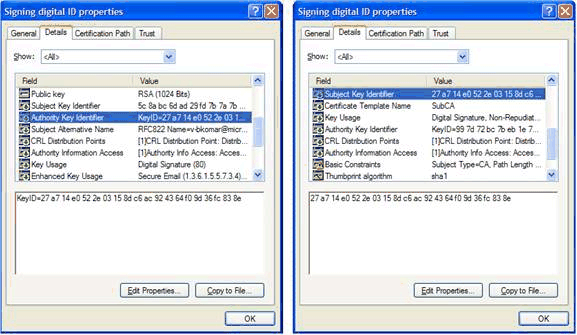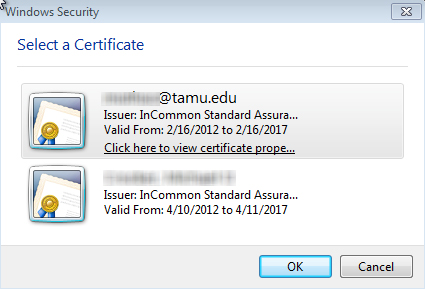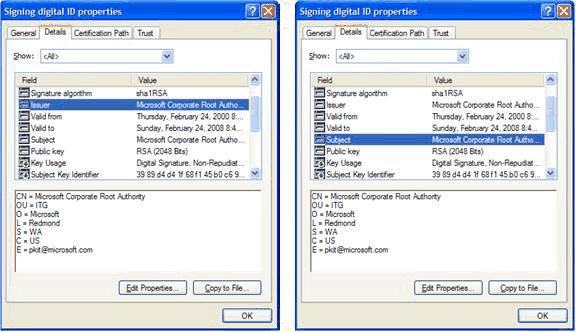Note: I am not an expert on PKI. This is a compendium of various recommendations and actions that Microsoft, NIST, and other well respected PKI and cryptography experts have said. If you see something that requires even the slightest revision, do let me know.
Before I get into configuring the CA and its subs, it's good to know that even though MSFT's CryptoAPI requires a self-signed root, some non-MSFT software may follow RFC 3280 and allow any CA to be the trusted root for validation purposes. One reason may be that the non-MSFT software prefers a lower key length.
Here are some configuration notes & guidance on setting up a CA ROOT and the Subs:
Storing the CA's Private Key
Best: Store the key on a HSM that supports key counting. Every time the CA's private key is used, the counter will be increased. This improves your audit profile.
Good: Store the Private key on a smart card. Though I'm unaware of any Smart Card that offers key counting, enabling key counting may give you unexpected results in the event log
Acceptable: Store the private key in Windows DPAPI. Ensure that these keys and the Key Enrollment agent don't end up in Roaming Credentials. See also: How to enumerate DPAPI and Roaming Credentials
Key Length
Don't use 1024 as a key length... NIST phased it out in 2011, MSFT won't ever add it into your Trusted Root CA store since it won't meet the minimum accepted technical criteria.
Root CAs that supports legacy apps should never be larger than 2048 bits. Reason: MSFT Support sees many cases where Java apps or network devices only support key sizes of 2048 bytes. Save the higher bit lengths to CAs that are constrained for a specific purpose (Windows vs Network devices) etc.
The NIST recommends 2048 or 3072 bits. ECC is supported, though it may cause issues with device interoperability.
Plan for the strongest possible encryption (key length) throughout the PKI, otherwise expect mixed security benefits.
Choosing a Hash
You may want to imitate the Federal PKI Management Authority and set up two PKI roots. One modern SHA-256 for all devices that support it, and one legacy SHA-1. Then use cross certificates to map between the two deployments.
Review this SHA-2 compatibility list for Microsoft software
Notably:
Windows 2003 and XP clients may need a patch for SHA2 Algorithms which include SHA256, SHA384, and SHA512. See more technical information
Authenticode and S/MIME with SHA2 hashing is not supported on XP or 2003
"Regarding SHA-224 support, SHA-224 offers less security than SHA-256 but takes the same amount of resources. Also SHA-224 is not generally used by protocols and applications. The NSA's Suite B standards also do not include it." source
"Do not use SHA2 suite anywhere in the CA hierarchy if you plan to have XP either trust the certificate, validate the certificate, use the certificate in chain validation, or receive a certificate from the CA. Even though XP SP3 allows validation of certiifcates that use SHA2 in the CA hierarchy, and KB 968730 allows limited enrollment of certificates that are signed by a CA using SHA2, any use of discrete signatures blocks out XP entirely." (source)
Choosing a Cryptographic Provider
- I'm not sure which one to choose so I'll post this link to a list of providers
CRL Distribution Point
Getting the CRL "right" is pretty important since it's up to each application to do the CRL check. For example smart card logon on domain controllers always enforce the revocation check and will reject a logon event if the revocation check cannot be performed or fails.
Note If any certificate in the chain cannot be validated or is found to be revoked, the entire chain takes on the status of that one certificate.
A self-signed root CA should not list any CDPs. Most windows applications don't enable the CERT_CHAIN_REVOCATION_CHECK_CHAIN_EXCLUDE_ROOT flag and therefore ignore the CDP (this is the default validation mode). If the flag is enabled, and the CDP is blank for the self signed root cert, no error is returned.
Don't use HTTPS and LDAPS. These URLs are no longer supported as distribution point references. Reason is that HTTPS and LDAPS URLs use certificates that may or may not be revoked. The revocation checking process can result in revocation loops when HTTPS or LDAPS URLs are used. To determine if the certificate is revoked, the CRL must be retrieved. However, the CRL cannot be retrieved unless the revocation status of the certificates used by HTTPS or LDAPS is determined.
Don't use LDAP- Although AD DS enables publication of CRLs to all domain controllers in the forest implement HTTP instead of LDAP for revocation information publication. Only HTTP enables the use of the ETag and Cache-Control: Max-age headers providing better support for proxies and more timely revocation information. In addition, HTTP provides better heterogeneous support as HTTP is supported by most Linux, UNIX, and network device clients.
Not using LDAP permits the revocation window to be smaller. When using AD LDAP to replicate CA information, the revocation window couldn't be less than the time for all sites in AD to get the CA update. Oftentimes this replication could take up to 8 hours... that is 8 hours until a smartcard user's access is revoked. 'Todo: the new recommended CRL refresh time is: ?????`
Make all the URLs highly available (aka don't include LDAP for external hosts). Windows will slow down the validation process for up to 20 seconds and retry the failed connection repeatedly at least as frequently as every 30 min. I suspect that Pre-fetching will cause this to occur even if the user isn't actively using the site.
Monitor the size of your CRL. If the CRL object is so large that CryptoAPI is not able to download the object within the allotted maximum timeout threshold, a “revocation offline” error is returned and the object download is terminated.
Note: CRL distribution over HTTP with ETAG Support may cause issues with IE6 when using Windows 2003 / IIS6, where the TCP connection is continually reset.
- (Optional) Enable Freshest CRL: This non-critical extension lists the issuers and locations from which to retrieve the delta CRLs. If the “Freshest CRL” attribute is neither present in the CRL nor in the certificate, then the base CRL will be treated as a regular CRL, not as part of a base CRL/delta CRL pair.
The Microsoft CA does not put the “Freshest CRL” extension into issued certificates. However, it is possible to add the “Freshest CRL” extension to an issued certificate. You would have to write code to add it to the request, write a custom policy module, or use certutil –setextension on a pending request. For more information about advanced certificate enrollment, see the “Advanced Certificate Enrollment and Management” documentation on the Microsoft Web site
Warning If delta CRLs are enabled at a CA, both the base CRL and delta CRL must be inspected to determine the certificate’s revocation status. If one of the two, or both, are unavailable, the chaining engine will report that revocation status cannot be determined, and an application may reject the certificate.
Authority Information Access
This field allows the Certificate validation subsystem to download additional certificates as needed if they are not resident on the local computer.
(I've seen conflicting advice on this:) A self-signed root CA should not list any AIA locations
A maximum of five URLs are allowed in the AIA extension for every certificate in the certificate chain. In addition, a maximum of 10 URLs for the entire certificate chain is also supported. This limitation on the number of URLs was added to mitigate the potential use of “Authority Info Access” references in denial of service attacks.
Don't use HTTPS and LDAPS. These URLs are no longer supported as distribution point references. Reason is that HTTPS and LDAPS URLs use certificates that may or may not be revoked. The revocation checking process can result in revocation loops when HTTPS or LDAPS URLs are used. To determine if the certificate is revoked, the CRL must be retrieved. However, the CRL cannot be retrieved unless the revocation status of the certificates used by HTTPS or LDAPS is determined.
Define a policy in issued certificates
The parent CA defines whether or not to allow CA certificate policies from sub CAs. It is possible to define this setting when a issuer or application policy needs to be included in a sub CA.
Example polices include an EKU for SmartCards, Authentication, or SSL/Server authentication.
Cross Certificate Distribution Points
This feature assists where environments need to have two PKIs installed, one for legacy hardware/software that doesn't support modern cryptography, and another PKI for more modern purposes.
Restricting EKU
In contrast with RFC 5280 that states “in general, [sic] the EKU extension will appear only in end entity certificates." the MSFT smart card implementation has interesting constraints around validating EKU.
If you're interested in having any EKU restrictions you should see this answer regarding OIDs and this regarding contrained certificates
Qualified Subordination for Intermediate CAs
Authority Key Identifier / Subject Key Identifier
Note If a certificate’s AKI extension contains a KeyID, CryptoAPI requires the issuer certificate to contain a matching SKI. This differs from RFC 3280 where SKI and AKI matching is optional. (todo: Why would someone choose to implement this?)

Give the Root and CA a meaningful name
People will interact with your certificate when importing it, reviewing imported certificates, and troubleshooting. MSFT's recommended practice and requirement is that the root has a meaningful name that identifies your organisation and not something abstract and common like CA1.
This next part applies to names of Intermediate/subCA's that will be constrained for a particular purpose: Authentication vs Signing vs Encryption
Surprisingly, End users and technicians who don't understand PKI's nuances will interact with the server names you choose more often than you think if you use S/MIME or digital signatures (etc).
I personally think it's a good idea to rename the issuing certificates to something more user friendly such as "Company Signer 1" where I can tell at a glance
- Who is the signature going to come from (Texas A&M or their rival)
- What is it used for? Encryption vs Signing
It's important to tell the difference between a message that was encrypted between two parties, and one that was signed. One example where this is important is if I can get the recipient to echo a statement I send to them. User A could tell user B "A, I owe you $100". If B responded with an echo of that message with the wrong key, then they effectively digitally notarized (vs just encrypting) a fictitious $100 debt.
Here is a sample user dialog for S/MIME. Expect similar UIs for Brower based certificates. Notice how the Issuer name isn't user friendly.

Alternate Encodings
Note: Speaking of names, if any link in the chain uses an alternate encoding, then clients may not be able to verify the issuer field to the subject. Windows does not normalize these strings during a comparison so make sure the names of the CA are identical from a binary perspective (as opposed to the RFC recommendation).

High Security/Suite B Deployments
Here is information regarding the Suite B algorithms supported in Windows 2008 and R2
ALGORITHM SECRET TOP SECRET
Encryption: Advanced Standard (AES) 128 bits 256 bits
Digital Signature: Elliptic Curve Digital Signature Algorithm (ECDSA) 256 bit curve. 384 bit curve
Key Exchange: Elliptic Curve Diffie-Hellman (ECDH) 256 bit curve. 384 bit curve
Hashing: Secure Hash Algorithm (SHA) SHA-256 SHA-384
For Suite B compliance, the
ECDSA_P384#Microsoft Software Key Service Provideras well as the384key size andSHA384as the hash algorithm may also be selected if the level of classification desired is Top Secret. The settings that correspond with the required level of classification should be used.ECDSA_P521is also available as an option. While the use of a 521 bit ECC curve may exceed the cryptographic requirements of Suite B, due to the non-standard key size, 521 is not part of the official Suite B specification.
PKCS#1 v2.1
XP clients and many non-windows systems do not support this new signature format. This should be disabled if older clients need to be supported. More Info
I would only recommend using it once you move to ECC algorithms for asymmetric encryption. (source)
